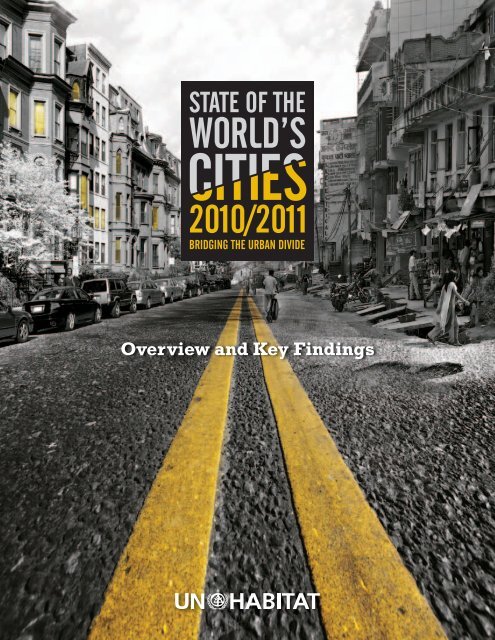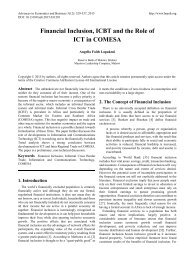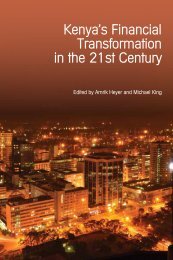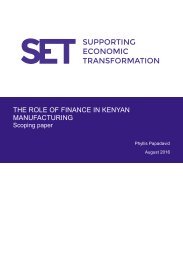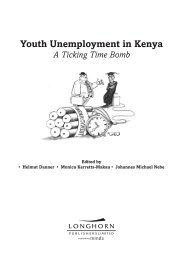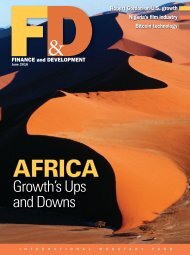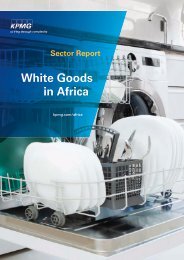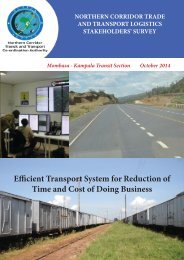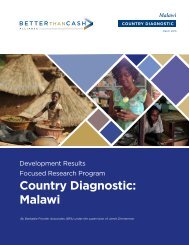11143016_alt
11143016_alt
11143016_alt
You also want an ePaper? Increase the reach of your titles
YUMPU automatically turns print PDFs into web optimized ePapers that Google loves.
AcknowledgementsCore TeamDirector: Oyebanji OyeyinkaCoordinator: Eduardo López MorenoStatistical Adviser: Gora MboupPrincipal Authors: Eduardo López Moreno, Oyebanji Oyeyinka, Gora MboupEditorial Management: Thierry Naudin, Rasna WarahEditorial Support: Darcy VarneySupport TeamContributors: Padmashree Sampath, Cecilia Zanetta, Miloon Kothari, Shivani Chaudhry, Christopher WilliamsResearch: Gianluca Crispi, Raymond Otieno Otieno, Anne AminGraphs: Gianluca Crispi, Azad Amir-Ghassemi, Raymond Otieno OtienoMaps: Jane ArimahStatistics: Julius Majale, Philip Mukungu, Souleymane Ndoye, Wandia Riunga, Barbara Agonga-Williams, Wladimir RayAdministrative Assistance: Anne Idukitta, Elizabeth Kahwae, Mary Dibo(The complete list of acknowledgements can be found in the full report.)Cover design and page layout: Michael Jones SoftwareCover montage: Boston Street ©Jorge Salcedo/Shutterstock and Kathmandu, Nepal ©Dhoxax/Shutterstock.Copyright © United Nations Human Settlements Programme, 2010.All rights reservedFor more information contact:United Nations Human Settlements Programme (UN-HABITAT)P.O. Box 30030, Nairobi, KenyaTel: +254 20 7621 234Fax: +254 20 7624 266/7E-mail: infohabitat@unhabitat.orgWebsite: www.unhabitat.orgDISCLAIMERThe designations employed and the presentation of the material in this report do not imply the expression of any opinion whatsoeveron the part of the Secretariat of the United Nations concerning the legal status of any country, territory, city or area, or of itsauthorities, or concerning delimitation of its frontiers or boundaries, or regarding its economic system or degree of development.The analysis, conclusions and recommendations of this report does not necessarily reflect the views of the United Nations HumanSettlements Programme or its Governing Council.
ForewordThe emerging picture of the 21st century city fitsmany descriptions. Some are centres of rapidindustrial growth and we<strong>alt</strong>h creation, oftenaccompanied by harmful waste and pollution.Others are characterized by stagnation, urban decay andrising social exclusion and intolerance. Both scenarios pointto the urgent need for new, more sustainable approaches tourban development. Both argue for greener, more resilientand inclusive towns and cities that can help combat climatechange and resolve age-old urban inequalities.The 2010/11 State of the World’s Cities Report, “Bridging theUrban Divide” examines the social, economic, cultural andpolitical drivers of urban poverty and deprivation. It arguesthat much inequality and injustice stems from inadequatepolicy-making and planning by local authorities and centralgovernments alike. Typical remedies include removingbarriers that prevent access to land, housing, infrastructureand basic services, and facilitating rather than inhibitingparticipation and citizenship. The report also emphasizes thatlasting gains are best achieved through a combination of localaction and national enabling policies.As we grapple with old and new challenges in a rapidlyurbanizing world, this timely report can help inform research,policy dialogue and development planning for years to come.I commend its findings to all who are working to create thejust, green and dynamic environments that the inhabitants ofthe world’s towns and cities need to thrive.Ban Ki-moonSecretary-GeneralUnited Nations
IntroductionThis State of the World’s Cities Report (2010/11)is published in a very important year – a keymilestone that marks the halfway point towards thedeadline for the “slum target” of the MillenniumDevelopment Goals. Government efforts to reduce thenumber of slum dwellers show some positive results.According to new estimates presented in this Report, betweenthe year 2000 and 2010 over 200 million people in thedeveloping world will have been lifted out of slum conditions.In other words, governments have collectively exceeded theMillennium Target by at least a multiple of two.However, this achievement is not uniformly distributed acrossregions. Success is highly skewed towards the more advancedemerging economies, while poorer countries have not doneas well. For this reason, there is no room for complacency,because in the course of the same years the number ofslum dwellers increased by six million every year. Based onthese trends it is expected that the world’s slum populationwill continue to grow if no corrective action is taken in thecoming years.This Report highlights the unprecedented challenges whichurbanization throws at the world’s cities today – particularlyin the South – and the attendant urban divide which we allhave to address collectively to stem the multiple deprivationsthat follow from unequal growth. These challenges includegrinding poverty, environmental degradation, income inequalities,historical socio-economic inequalities, marginalizationand various forms of exclusion.Achieving sustainable urban development is likely to proveimpossible if the urban divide is allowed not only to persist,but to continue growing, opening up an enormous gap, evenin some cities a gulf, an open wound, which can producesocial instability or at least generate high social and economiccosts not only for the urban poor, but for society at large.This edition of the Report underlines the choices available topolicymakers across the range of economic, social, culturaland political challenges that are needed to bridge the urbandivide. It charts a new course of action, with the steps andlevers needed to achieve a more inclusive city, emphasizingthe need for comprehensive and integrated responses that gobeyond a compartmentalized, short-term perspective.The Report benefits enormously from context-specificknowledge drawing in large part on regional perspectives andinformation, in a bid to inspire evidence-based local policyresponses. In that sense, this Report contributes to bridge thegap between scientific information and societal action, whichis a simple, but fundamental requisite, to promote equity andsustainability for more harmonious cities.Anna K. TibaijukaUnder-Secretary-General and Executive DirectorUnited Nations Human Settlements Programme(UN-HABITAT)
Overview and Key FindingsThe world is inexorably becoming urban. By 2030all developing regions, including Asia and Africa,will have more people living in urban than ruralareas. In the next 20 years, Homo sapiens, “the wisehuman”, will become Homo sapiens urbanus in virtually allregions of the planet.Cities – whether large or small, whole neighbourhoods, citycentres, suburban or peri-urban areas – offer human beingsthe potential to share urban spaces, participate in publicand private events and exercise both duties and rights. Theseopportunities in turn make it possible to cultivate societalvalues and define modes of governance and other rules thatenable human beings to produce goods, trade with others andget access to resources, culture, and various forms of riches orwell-being.Cities can be open or closed with regard to residents’ abilityto access, occupy and use urban space, and even produce newspaces to meet their needs. Cities can also be open or closedin terms of residents’ ability to access decisions and participatein various types of interaction and exchange. Some residentsfind the city as the place where social and political life takesplace, knowledge is created and shared, and various forms ofcreativity and art are developed; other residents find that thecity denies them these opportunities. Cities can therefore beplaces of inclusion and participation, but they can be alsoplaces of exclusion and marginalization.The Urban DivideCities are constantly changing. They are built, rebuilt,transformed, occupied by different groups, and usedfor different functions. In the search for better spatialorganization for higher returns, more efficient economies ofscale and other agglomeration benefits, cities generate variousdegrees of residential differentiation. In most urban areas ofthe developed world, the segmentation of spaces for differentuses is relatively visible, <strong>alt</strong>hough social heterogeneity andmixed uses remain widespread. In contrast, in many cities ofthe developing world, the separation of uses and degrees ofprosperity are so obvious that the rich live in well-servicedneighbourhoods, gated communities and well-built formalsettlements, whereas the poor are confined to inner-city orperi-urban informal settlements and slums.Cities, particularly in the South, are far from offering equalconditions and opportunities to their resident communities.The majority of the urban population is prevented from, orrestricted in, the fulfillment of their basic needs because oftheir economic, social or cultural status, ethnic origins, genderor age. Others, a minority, benefit from the economic andsocial progress that is typically associated with urbanization.In some of these cities, the urban divide between “haves” and“have nots” opens up a gap – if not, on occasion, a chasm,an open wound – which can produce social instability or atleast generate high social and economic costs not only for theurban poor, but for society at large.Cities are, more often than not, divided by invisible borders.These split the “centre” from the “off-centre”, or the “high”from the “low”, as the urban divide is colloquially referred toin many parts of the South. These man-made demarcationsare often completely different along a spatial and socialcontinuum, reflecting the only difference experienced bytheir respective populations: socio-economic status. Closerassessment of the urban space in many cities of the developingworld sheds forensic light on the fragmentation of society,marking out differences in the way space and opportunitiesare produced, appropriated, transformed and used. Some areasfeature significant infrastructure, well-kept parks, gardensand up-market residential areas. In contrast, other areas arecharacterized by severe deprivation, inadequate housing,deficient services, poor recreation and cultural facilities, urbandecay, and scarce capital investment in public infrastructure.These tangible differences in access come as symptoms of theintangible yet enduring divisions in society that apportionunequal opportunities and liberties across residents.The physical divide takes the form of social, cultural andeconomic exclusion. Large sections of society are frequentlyexcluded on grounds of predetermined attributes over whichthey have no control at all, such as gender, age, race, orethnicity, or over which they have very little control, suchas where they live (slums vs. rich neighbourhoods) or whatthey own (income and social status). However, this narrowperspective overlooks the actual and potential contributionsof marginalized groups to the building of cities and nations,and therefore can only delay progress toward sustainable andinclusive development.The urban divide is the face of injustice and a symptom ofsystemic dysfunction. A society cannot claim to be harmoniousor united if large numbers of people cannot meet theirbasic needs while others live in opulence. A city cannot beharmonious if some groups concentrate resources and opportunitieswhile others remain impoverished and deprived.Yet cities are not – and should not be – “the world whichman created, and therefore the world in which he is henceforthcondemned to live”. Cities are, on the contrary, vehiclesfor social change: places where new values, beliefs and ideascan forge a different growth paradigm that promotes rightsand opportunities for all members of society. Based not onlyon moral and ethical arguments but also practical access toopportunity, the concept of an “inclusive city”, or “a city forall”, encompasses the social and economic benefits of greaterequality, promoting positive outcomes for each and every individualin society.
1 Urban TrendsUrbanization: A Positive Force for TransformationBy the mid-20 th century, three out of 10 people onthe planet lived in urban areas. At that time, and over thefollowing three decades, demographic expansion was at itsfastest in cities around the world. Subsequently, a slow butsteady process of deceleration took over. Today, half theworld’s population lives in urban areas and by the middle ofthis century all regions will be predominantly urban, withthe tipping point in Eastern Africa anticipated slightly after2050. According to current projections, virtually the whole ofthe world’s population growth over the next 30 years will beconcentrated in urban areas.Although many countries have adopted an ambivalentor hostile attitude to urbanization, often with negativeconsequences, it appears today that this worldwide process isinevitable. It is also generally positive, as it brings a numberof fundamental changes, namely: (a) in the employmentsector, from agriculture-based activities to mass productionand service industries; (b) in societal values and modes ofgovernance; (c) in the configuration and functionality ofhuman settlements; (d) in the spatial scale, density andactivities of cities; (e) in the composition of social, culturaland ethnic groups; and (f) in the extension of democraticrights, particularly women’s empowerment.Using a we<strong>alt</strong>h of significant and comparative new data, thisReport identifies the trends, both similar and dissimilar, thatcharacterize urbanization in various regions and countries; itdoes so against a background of significant recent changes,such as accelerated expansion or shrinking of cities, ageingpopulations, urban and regional dynamics and regionallocation factors, among others. In this respect, it is worthmentioning two significant trends that can either help bridgeor exacerbate the urban divide:• Cities are merging together to create urban settlementson a massive scale. These configurations take the form ofmega-regions, urban corridors and city-regions. They areemerging in various parts of the world, turning into spatialunits that are territorially and functionally bound by economic,political, socio-cultural, and ecological systems.Cities in clusters, corridors and regions are becoming thenew engines of both global and regional economies, andthey reflect the emerging links between urban expansionand new patterns of economic activity. However, asthey improve inter-connectivity and create new forms ofinterdependence among cities, these configurations canalso result in unbalanced regional and urban developmentas they strengthen ties to existing economic centres,rather than allow for more diffused spatial development.STATE OF THE WORLD’S CITIES 2010/2011 - OVERVIEWMAP 1.1: SELECTED GLOBAL CITY-REGIONS, URBAN CORRIDORS AND MEGA-REGIONSCity-regionsNUrban corridorsMega-regionsSource: UN-HABITAT Regional Offices, 2009.4
STATE OF THE WORLD’S CITIES 2010/2011 - OVERVIEWFIGURE 1.1: AVERAGE ANNUAL GROWTH RATE OF SELECTED FASTGROWING CITIES IN AFRICA BETWEEN 1990 AND 2006Rate of growth Rate of (%) Rate growth of growth (%) (%)252520252015201510151051050NakuruDire DawaFèsYaoundéLagosLoméKhartoumNairobiNairobi Addis AbabaKampalaFIGURE 1.2: AVERAGE ANNUAL GROWTH RATE OF SELECTED FASTGROWING CITIES IN ASIA BETWEEN 1990 AND 200625Rate of growth Rate of (%) Rate growth of growth (%) (%)FIGURE 25 1.3: AVERAGE ANNUAL GROWTH RATE OF SELECTED FASTGROWING CITIES IN LATIN AMERICA AND CARIBBEAN REGIONBETWEEN 25 1990 AND 200620Rate of growth Rate of (%) Rate growth of growth (%) (%)50025201520151015105105013.3Nakuru25 20.820505013.3Nakuru7.5Dire Dawa7.8 7.47.8 7.45.7FèsYaoundé5.7 5.7 5.3 5.1 4.95.7 5.7 5.3 5.1 4.9LagosLoméKhartoumAddis Ababa4.1 4.0ShenzhenShenzhenDongguanDongguanChongqingShenzhenChongqingKarajDongguanKarajGuangzhouChongqingGuangzhouKalookanKarajKalookanShanghaiGuangzhouShanghaiFaridabadKalookanFaridabadSeongnamShanghaiSeongnamNashikFaridabadNashikSuratSeongnamSuratPuneNashikPuneRajkotSuratRajkotChandigarhPuneChandigarhPadangRajkotPadangBeijingChandigarhPuente AltoBeijingPadangPuente AltoSanta CruzBeijingPuente Alto Santa CruzSanta Cruz TijuanaMaracaiboTijuana Maracaibo ValenciaMaracaibo Valencia Ciudad JuárezValencia Ciudad Juárez Port-au-PrinceCiudad Juárez Port-au-Prince MaceióPort-au-Prince Maceió Campo Maceió Campo GrandeGuadalajaraCampo Grande Guadalajara Santa Fé De BogotáGuadalajara Santa Fé De BogotáSanta Fé De Bogotá4.3 4.3 4.2 4.0 4.0 3.5 3.4 3.24.1 4.0Kampala25 20.8201520.8 13.1201511.310 13.111.3 8.0 7.715106.513.15.6 5.4 5.358.0 7.74.9 4.8 4.8 4.6 4.6 4.6 4.511.36.5105.6 5.4 5.354.9 4.8 4.8 4.6 4.6 4.6 4.58.0 7.706.5 5.6 5.4 5.3 4.9 4.8 4.8 4.6 4.6 4.6 4.50013.37.57.5Dire Dawa7.8 7.45.75.7FèsYaoundé5.7 5.7 5.3 5.1 4.9LagosLoméKhartoumNairobiAddis Ababa4.3 4.3 4.2 4.0 4.0 3.5 3.4 3.24.3 4.3 4.2 4.0 4.0 3.5 3.4 3.2Source: Demographic Yearbook, Various Years 1990 - 2006.4.1 4.0Kampala2.42.42.4The We<strong>alt</strong>h of CitiesThe prosperity of nations is intimately linked to theprosperity of their cities. No country has ever achieved sustainedeconomic growth or rapid social development withouturbanizing (countries with the highest per capita income tendto be more urbanized, while low-income countries are theleast urbanized). Thanks to superior productivity, urban-basedenterprises contribute large shares of gross domestic product(GDP). In other countries, it is a group of cities that accountsfor a significant share of national GDP. The clustering ofcities into mega-regions, urban corridors and city-regionsoperating as single economic entities sets in motion selfreinforcing,cumulative growth patterns that are making asignificant contribution to the world’s economic activity.High urban densities reduce transaction costs, make publicspending on infrastructure and services more economicallyviable, and facilitate generation and diffusion of knowledge,all of which are important for growth. Hand in hand witheconomic growth, urbanization has helped reduce overallpoverty by providing new opportunities, raising incomes andincreasing the numbers of livelihood options for both ruraland urban populations. Urbanization, therefore, does indeedplay a positive role in overall poverty reduction, particularlywhere supported by well-adapted policies. However, whenaccompanied by weak economic growth, or when distributivepolicies are nonexistent or ineffective, urbanization resultsin local concentration of poor people rather than significantpoverty reduction.Cities have the potential to make countries rich because theyprovide the economies of scale and proximity that generateenhanced productivity. Economic growth can turn urban centresinto effective “poverty fighters” if benefits and opportunitiesare redistributed through adequate policies. Cities can alsosignificantly reduce rural poverty.Slums: Good News is Shadowed by Bad NewsIn many developing countries, urban expansion has oftenbeen characterized by informality, illegality and unplannedsettlements. Above all, urban growth has been stronglyassociated with poverty and slum growth. Fortunately, anumber of countries have, to some extent, managed to curbthe further expansion of slums and to improve the livingconditions prevailing there. Uneven as they may have beenaround the world, efforts to narrow the most unacceptableform of urban divide as represented by slums have yieldedsome positive results. According to UN-HABITAT estimates,between the year 2000 and 2010, a total 227 million peoplein the developing world will have moved out of slumconditions. In other words, governments have collectivelyexceeded the slum target of Millennium Development Goal7 by at least 2.2 times, and 10 years ahead of the agreed 2020deadline.6
Improving the lives of slum dwellers is the best way to achieve all theMillennium Development Goals. Improved housing conditions andprovision of water and sanitation will not only save lives among the verypoor, but also support progress in education and he<strong>alt</strong>h.FIGURE 1.4: BRIDGING THE URBAN DIVIDE THROUGH SLUMIMPROVEMENT: THE MOST SUCCESSFUL COUNTRIESSouth AfricaMoroccoTurkeyColombiaArgentinaEgyptMexicoNigeriaBrazilIndonesiaIndiaChina1.962.433.513.724.945.015.088.0510.3821.230 10 20 30 40 50 60 70 80Slum improvements in absolute numbers (2000-2010) millionsSource: UN-HABITAT - GUO, 2009. Note: 2010 data are predictions.59.7365.31sub-region, reducing the proportions of slum dwellers by overone-fifth in the last decade.Some 13 per cent of the progress made towards the globalslum target occurred in Latin America and the Caribbean,where an estimated 30 million people have moved out ofslum conditions since the year 2000. Over the past decade,Argentina, Colombia and Dominican Republic have beenable to reduce their proportions of slum dwellers by over athird, making them the most successful countries in theregion.The successful municipalities took the responsibility for slumreduction squarely on their shoulders, backing commitmentswith bold policy reforms, and preventing future slum growthwith equitable planning and economic policies. Recognition ofthe existence of slums must combine with long-term politicalcommitment backed by adequate budget resources, policy reformsand institutional strengthening, strong monitoring and scalingup of successful local projects, if slums are to be tackled effectively.Asia stood at the forefront of successful efforts to reachthe slum target, with governments in the region togetherimproving the lives of an estimated 172 million slum dwellersbetween the year 2000 and 2010; this represents 74 percent of the total number of urban residents in the worldwho no longer suffer from inadequate housing. China andIndia have improved the lives of more slum dwellers thanany other countries, having together lifted no less than 125million people out of slum conditions in the same period.After China and India, the most significant improvementsin slum conditions in Asia were recorded in Indonesia,Turkey and Viet Nam. At sub-regional level, the greatestadvances were recorded in Southern and Eastern Asia (73and 72 million people, respectively), followed by South-EastAsia (33 million). In contrast, Western Asia failed to makea contribution, as the number of slum dwellers in the subregionincreased by 12 million.Across Africa, the lives of an estimated 24 million slumdwellers have improved in the last decade, representing 12per cent of the global effort to narrow this form of urbandivide. North Africa is the only sub-region in the developingworld where both the number (8.7 million) and proportionof slum dwellers have steadily declined (from 20 to 13 percent). Egypt, Morocco and Tunisia were the most successfulcountries. In sub-Saharan Africa, though, the total proportionof the urban population living in slums has decreased by only5 per cent (or 17 million people). Ghana, Senegal, Uganda,Rwanda and Guinea were the most successful countries in theIn all developing regions, improving the lives of slum dwellerscalls for macro-level programmes that include housinginfrastructure and finance, improved water and sanitation,and adequate living spaces. However, these macro-levelprogrammes must be associated with micro-level schemes,including micro-credit, self-help, education and employment.The fact that an additional 227 million urban dwellershave gained access to improved water and sanitation aswell as to durable and less crowded housing shows thata number of countries and cities are taking the slumtarget seriously. This enhances the prospects for millionsof people to escape poverty, disease and illiteracy, andto lead better lives thanks to a narrower urban divide.Over the past 10 years, the proportion of the urbanpopulation living in slums in the developing world hasdeclined from 39 per cent in the year 2000 to an estimated32 per cent in 2010. And yet the urban divide endures,because in absolute terms the numbers of slum dwellers haveactually grown considerably, and will continue to rise in thenear future. Between the year 2000 and 2010, the urbanpopulation in the developing world increased by an estimatedaverage of 58 million per annum; this includes 6 millionwho were not able to improve their conditions and joinedthe ranks of slum dwellers. At the same time, UN-HABITATestimates that through upgrading or prevention of informalsettlements, developing countries lifted an annual 22 millionURBAN TRENDS7
people out of slum conditions between the year 2000 and2010. Based on these trends, the world’s slum population isexpected to reach 889 million by 2020.Good news is coming with bad news. UN-HABITATestimates confirm that the progress made on the slumtarget has not been enough to counter the demographicexpansion in informal settlements in the developingworld. In this sense, efforts to reduce the numbers ofslum dwellers are neither satisfactory nor adequate.Against this background, it is up to national governmentsto revise and increase the slum target to a number that takesinto account both existing and potential new slums. Thosenations that have been performing well so far must maintainor increase efforts to improve the living conditions of slumdwellers, while providing adequate <strong>alt</strong>ernatives to prevent newslum formation. Those governments that are falling behind inslum reduction must bring radical changes to their attitudesand policies vis-à-vis slums and urban poverty at large.Efforts must focus on those regions facing the greatest developmentchallenges in slum reduction: sub-Saharan Africa and WesternAsia. Others in need of special attention are those countrieswhich, for all their overall progress toward the slum target atnational level, are still faced with huge spatial inequalities insome regions and cities. Finally, efforts are also required in thosecities which, <strong>alt</strong>hough they are doing relatively well, still featurelarge pockets of poverty where people remain marginalized.STATE OF THE WORLD’S CITIES 2010/2011 - OVERVIEWsJakarta. Indonesia has achieved a substantial reduction in the number of slum dwellers. ©Kzenon/Shutterstock8
No data< 20.020.0 - 40.040.1 - 60.060.1 - 70.0> 70.0Source: UN-HABITAT, Global Urban Observatory, 2009.No data< 20.0N20.0 - 40.0N40.1 - 60.060.1 - 70.00 > 70.0 1,500 3,000 Kms0 1,500 3,000 KmsSource: UN-HABITAT, Global Urban Observatory, 2009.No No data data< 20.0 10.020.0 10.0 -- 40.0 20.040.1 20.1 -- 60.0 30.060.1 30.1 -- 70.0 40.0> 70.0 40.0Source:Source:UN-HABITAT,UN-HABITAT,GlobalGlobalUrbanUrbanObservatory,Observatory,2009.2009.N001,5001,7003,000 Kms3,400 KmsNo data< 10.010.0 - 20.020.1 - 30.030.1 - 40.0> 40.0Source: UN-HABITAT, Global UMAP 1.2: SLUM PROPORTIONS OF SELECTED COUNTRIES INMAP 1.2: SLUM PROPORTIONS OF SELECTED COUNTRIES IN LATINAFRICA (2005)AMERICA AND THE CARIBBEAN (2005)Slum proportions of selected countries in Africa (2010)Slum proportions of selected countriesSlum proportions of selected countries in Africa (2005) Slum proportions of selected countries in Africa (2010)in Latin America and The Caribbean (2005)Percentage slum (%) in 2010No data< 20.020.0 - 40.040.1 - 60.060.1 - 70.0> 70.0Source: UN-HABITAT, Global Urban Observatory, 2009.Percentage slum (%) in 2005No data< 20.0N20.0 - 40.040.1 - 60.060.1 - 70.00 > 70.0 1,500 3,000 Kms0 1,500 3,000 KmsSource: UN-HABITAT, Global Urban Observatory, 2009.Percentage slum (%) in in 2010 2005No data< 20.0 10.020.0 10.0 -- 40.0 20.040.1 20.1 -- 60.0 30.060.1 30.1 -- 70.0 40.0> 70.0 40.0Source: UN-HABITAT, Global Urban Observatory, 2009.N0 0 1,500 1,700 3,000 Kms 3,400 KmsPercentage slum (No data< 10.010.0 - 20.020.1 - 30.030.1 - 40.0> 40.0Source: UN-HABITAT, Global UMAP 1.3: SLUM PROPORTIONS OF SELECTED COUNTRIES IN ASIA (2005)Slum proportions of selected countries in Asia (2005)STATE OF THE WORLD’S CITIES 2010/2011 - OVERVIEWPercentage slum (%) in 2005No data< 15.015.0 - 25.025.1 - 35.035.1 - 50.0> 50.0Source: UN-HABITAT, Global Urban Observatory, 2009.N0 2,500 5,000 Kms10
BOX 1.1: FROM BLIND SPOT TO SPOTLIGHT: FIVE POLICY STEPS TO SLUM REDUCTIONsBogot‡ . In Colombia, an estimated 3.7 million slumdwellers have benefited from well-targeted slumupgrading and prevention strategies.©Tifonimages/ShutterstockSlums have only on occasion proved to be whatmost public authorities wished they would: atransient phenomenon, which growth and higherincomes would eliminate over time. In too manycities today, all-too visible slums remain blindspots for policymakers - caught as they arebetween token gestures, clearance or masseviction, or administrative Ò pass the buckÓ . Theodd attempt at institutional response and reformtypically founders on lack of support, funding orcoordination. Still, municipalities in a number ofcountries (representing about one-third of thoseknown as “developing”) have managed to reducethe absolute and relative numbers of slumdwellersamong their populations.How did they do it? The successfulgovernments took the responsibility for slumreduction squarely on their shoulders, backingcommitments with bold policy reforms, andpreventing future slum growth with equitableplanning and economic policies. Recentpolicy evidence collected by UN-HABITAT in44 successful countries suggests that slumreduction takes a combination of five specific,complementary approaches: (1) awareness andadvocacy; (2) long-term political commitment;(3) policy reforms and institutional strengthening;(4) implementation and monitoring; (5) andscaling-up of successful local projects.Awareness and advocacy. For localauthorities and other stakeholders, awarenessrequires slum monitoring systems and indicatorsto collect information and analyse trends, likethose that have been successful throughout VietNam, Brazil and Indonesia. Advocacy involvesdisseminating messages on improved livingconditions for slum dwellers, as governmentsSources: Bazoglu, 2007; Chowdhury, 2006; López Moreno, 2003; UN-HABITAT, 2008.in Brazil, India and Mexico have done. Civilsociety organizations can also encourage politicalcommitment and champion the views andrights of slum dwellers and the poor in general- either as watchdogs like Réseau Social WatchBŽ nin that monitor Millennium DevelopmentGoals and poverty reduction strategies, or aspartners in government-funded programmes, likeMexicoÕ s Hábitat y Rescate de Espacios Públicos(Reappropriation of public space). Organizationslike Shack/Slum Dwellers International onoccasion perform both an advocacy and anexecuting role.Long-term political commitment. Over thepast 15 years, consistent political commitmentto large-scale slum upgrading and serviceprovision to the urban poor has enabled China,India, Turkey, Dominican Republic, Colombia,Egypt, Morocco and Tunisia to reduce andstabilize slums. Other countries, including Ghana,Senegal and Argentina have fairly recentlystepped up action, and yet others have begunto gather the necessary political support for landand tenure policy reforms, including BurkinaFaso, Senegal and Tanzania.Policy reform and institutionalstrengthening. The policy reforms requiredfor slum upgrading and prevention involvehousing, land and infrastructure provision andfinance. Indonesia, Nicaragua and Peru haveintegrated large numbers of urban poor intothe legal and social fabric; other countries, likeIndia, have deployed major pro-poor reformsand programmes for land and housing provisionor are adopting more inclusive approaches.Costa Rica, Ecuador and Colombia look to avoidrelocations and instead work on settlements insitu, improving existing living conditions. Mostof the more successful countries - includingIndonesia, Iran, Mexico, Philippines, South Africaand Turkey - look beyond the housing sectorand fight slums as part of broader-ranging urbanpoverty reduction strategies. Policies have tendedto shift from entitlement to co-participation,where financial viability and down-paymentscondition access to public subsidies for both newhousing and improvements. Creation of a HumanSettlements Ministry gives higher visibility andcontinuity to the cause as demonstrated inBurkina Faso. Municipal decentralization throughcommunity-based consultation mechanisms isanother avenue that has succeeded in Cambodia,Malawi and Zambia.Implementation and monitoring. Countriesthat performed well on the Millennium slumtarget (including Indonesia and South Korea)deployed transparent and pro-poor policiesbacked up by adequate human and technicalresources. Others, such as Colombia, Chile,the Philippines and South Africa, also trainedurban planning and management professionalsand involved them in housing and basicservice delivery programmes. The mostsuccessful countries (China, Viet Nam, Chile,Sri Lanka and Peru) coordinated slum policyimplementation between central regional andmunicipal authorities and the private sector.Other countries set themselves national targets:Cambodia (100 slum communities upgradedevery year); Chile, Brazil, Morocco and Thailand(all of which enacted clear slum targets andbenchmarks as part of urban poverty reduction).Indonesia uses results-based monitoring andsatisfaction surveys.Scaling-up. Replication and scaling-up ofsuccessful, local one-off or pilot slum-upgradingprojects have served Brazil, Mexico, Colombia,South Africa, Sri Lanka and Indonesia well withmeasurable impacts on national indicatorsof slum growth. As originally modest-scaleprogrammes were upgraded in Brazil, Egypt,Nicaragua and Turkey, the private sector andcivil society became involved, or the schemesbenefited from additional funding for replicationand mainstreaming into government policies. InBurkina Faso and Senegal, reforms started in the1980s in the capital city and expanded into largescalephysical and tenure upgrading schemesfor irregular settlements across the country.Other countries, including China, Chile and SouthAfrica, engaged in large-scale public subsidies tothe housing sector, in a bid to reach the poorestgroups and meet the rising costs of socialhousing. In most cases, success mobilized hugedomestic (and, on occasion, external) resourcesto promote innovative strategies, including forslum prevention.Policy analysis shows that on top of acombination of these five elements, successon the Millennium slum target involves propercoordination between cohesive, well-designedand adequately resourced centralizedinterventions on the one hand, and localauthorities on the other hand.URBAN TRENDS11
2 The Urban DivideSTATE OF THE WORLD’S CITIES 2010/2011 - OVERVIEWThe urban divide does not just refer to a fragmented spaceor a community riven by socio-economic disparities. Moreoften than not, economic lines of divide tend to coincidewith social, cultural and political barriers. Various forms ofexclusion continue to marginalize vast amounts of humancapital ready to be mobilized for the sake of a sustainable city.A divided city is one that fails to accommodate its poorerresidents, regardless of the social and cultural riches theymight contribute. Social divisions can permeate interactionsamongst individuals even in the absence of significantethnic, racial or other factors of segregation. Fresh divisionsconstantly emerge and become entrenched; patterns of socialinclusion and exclusion preserve benefits for specific socialsegments based on physical location, shared interests, historicinequalities or other criteria.If the four dimensions of the inclusive city – social, political,economic and cultural – are to be turned from a mere conceptualparadigm into reality, they must be implemented within arights-based framework, and one that is easy to enforce. Shortof this, prevailing patterns of exclusionary development, selectivebenefit-sharing, marginalization and discrimination willcontinue unabated in cities. City efforts to design and implementstrategies for inclusiveness must be based on a clear and cogentrepresentation of the way these four dimensions can be integratedconcurrently into the day-to-day lives of the population.Only through explicit and deliberately inclusive processes willit be possible to identify the locally appropriate, innovative andhigh-leverage actions and policies which government, publicofficials and major institutions can deploy to set in motion selfreinforcingprocesses that will bridge the urban divide.Income Inequality in Cities: Contrasting NumbersIn general terms, income inequalities in developed countriesare low. However, <strong>alt</strong>ogether, income inequalities in developedcountries increased between the mid-1980s and 2005.Little is known about inequalities in European urban areasspecifically, as available data is generally not disaggregated toindividual cities. Still, nationwide aggregates do not alwaysaccurately reflect disparities in general urban or city-specificincomes. The most surprising variations between nationaland city-specific Gini coefficients of income or consumptiondisparities are found in the United States of America, wherearound 2005 the national coefficient stood at 0.38, butexceeded 0.5 in many major metropolitan areas includingWashington, D.C.; New York City; Miami; and others.These values are comparable to the average Gini coefficientsof cities in selected Latin American countries, where incomeinequality is particularly steep.Income inequalities are higher in the developing world thanin developed nations. New data presented by UN-HABITATon Gini coefficients shows mixed results in the various regionsof the South.In general, urban inequality in Latin America and theCaribbean is declining, <strong>alt</strong>hough it remains quite high.An analysis of income distribution trends in 17 selectedcountries in the region shows that in nine of them, urbanGini coefficients have fallen slightly between the late 1990sand 2006. However, in the urban areas of five other LatinAmerican countries, income inequalities have slightly risenor remained stable. The recent improvement in economicconditions in various countries across the region has resultedin a narrower income gap between rich and poor. However,the current financial and food crises are likely to dampen thechances for sustained economic growth in coming years, andshort of appropriate pro-poor policies, inequalities may riseagain, instead of declining further.Trends in the economic divide in Africa’s urban areas aremixed. Among the 13 countries under review, eight showedlower values (if only marginally for some) and five featuredmoderate to significant increases. The region’s urban areas, insub-Saharan Africa in particular, retain the highest degreesof poverty in the world, together with the highest prevalenceof slum populations in urban areas. In African urban areas,progress in poverty reduction has been rather slow overall,but these mixed results in the distribution of income andconsumption point to the hope of future improvements.In Asia, the economic urban divide is widening. Althoughincome and consumption inequality is low to moderateoverall, average incomes have increased in almost all Asiancountries, and poverty has fallen nearly everywhere in theregion, with the exception of Bangladesh.African cities appear to be the most unequal in the world(sample of 37 cities with an average Gini coefficient of 0.58).Next come Latin American cities (24 cities, with a Giniaverage of 0.52). Asian cities (30) feature a comparativelylow degree of income inequality, as measured by a Ginicoefficient of 0.384. Eastern Europe (8) and CIS cities (10)feature the lowest average Gini values and, presumably, thegreatest degrees of equality, at 0.298 and 0.322, respectively.12
sKuala Lumpur. ©Mark Henley/Panos PicturesHighly unequal income or consumption patterns in cities in thedeveloping world point to institutional and structural failures,as well as to broader economic problems such as imbalancedlabour markets or a lack of pro-poor policies. The more unequ<strong>alt</strong>he distribution of income or consumption in urban areas, thehigher the risk that economic disparities will result in social andpolitical tension.Space Inequality: The Poverty TrapThe spatial divide in developing country cities does not justreflect income inequalities among households; it is also a byproductof inefficient land and housing markets, ineffectivefinancial mechanisms and poor urban planning. Whileincome inequalities are a major divisive social factor, thespatial inequalities visible in so many cities are an outgrowth ofboth socioeconomic disparities and larger processes of urbandevelopment, governance and institutionalized exclusion ofspecific groups.When slum areas are physically isolated and disconnectedfrom the main urban fabric, residents become cut off fromthe city, often enduring longer commuting times and highertransportation costs than they would if their neighbourhoodswere more integrated into urban networks. On top of lowincomes and shelter deprivations, these residents findthemselves underprivileged in terms of access to the urbanadvantage. Combined, the physical and social distancebetween poor and rich neighbourhoods represents a spatialpoverty trap marked by six distinct challenges: (a) severe jobrestrictions; (b) high rates of gender disparities; (c) deterioratedliving conditions; (d) social exclusion and marginalization; (e)lack of social interaction, and (f) high incidence of crime.Absence of policy coordination between or within national andlocal government constrains cities’ ability to meet the requirementsof urban development and to deploy strategies that mitigatespatial inequality.More gender-specific schemes, like maternity and childcarebenefits, vocational training, protecting women’s rights at theworkplace, and micro-credit are required if women are to belifted out of the spatial poverty trap.THE URBAN DIVIDE13
MAP 2.1: URBAN INEQUALITIES (CONSUMPTION/INCOME) IN SELECTEDCITIES AND COUNTRIES IN AFRICA (1993-2007)MAP 2.2: URBAN INEQUALITIES (INCOME) IN SELECTED CITIES ANDCOUNTRIES IN LATIN AMERICA AND THE CARIBBEAN (1998-2007)Mexico CityPort-Au-PrinceCaracasDakar ")BissauFreetown ")") ")AbidjanIkejaDoualaBrazzavilleUrban Gini CoefficientsIncome (1993-2008) Consumption (1997-2007)No data0.30 - 0.390.40 - 0.490.50 - 0.590.60 - 0.690.70 - 0.76City Gini CoefficientsIncome (1996-2008) Consumption (1998-2007)0.30 - 0.390.40 - 0.490.50 - 0.590.60 - 0.690.70 - 0.75Windhoek0 1,500 3,000 Kms")")")")")")")")0.31 - 0.390.40 - 0.490.50 - 0.580.26 - 0.290.30 - 0.390.40 - 0.490.50 - 0.590.60 - 0.69")") ")")")")") ")")Cape Town")")")")")")")")")") MaputoDurbanPort Elizabeth")")")")")")Addis AbabaNairobi") Dar es SalaamSource: UN-HABITAT, Global Urban Observatory, 2009.Note: Data from various sources, and for various years.City Ginis for CAR, Ghana, Malawi, Namibia, Nigeria and Togo are basedon regional/state data.Urban GiniCoefficientNo data0.30 - 0.390.40 - 0.490.50 - 0.590.60 - 0.69Guatemala CityManaguaCity GiniCoefficient0.20 - 0.290.30 - 0.390.40 - 0.490.50 - 0.590.60 - 0.690.70 - 0.75BogotáQuito0 1,750 3,500 KmsSantiagoFortazelaBrasiliaRio de JaneiroSão PauloMontevideoBuenos AiresSource: UN-HABITAT, Global Urban Observatory, 2009.Note: Data from various sources, and for various years.All Gini Coefficients are for income.MAP 2.3: URBAN INEQUALITIES (CONSUMPTION/INCOME) IN SELECTED CITIES AND COUNTRIES IN ASIA (1996-2007)UlaanbaatarSTATE OF THE WORLD’S CITIES 2010/2011 - OVERVIEWDamascusUrban Gini CoefficientsIncome (1996-2003) Consumption (1999-2007)No data0.30 - 0.390.40 - 0.450.30 - 0.390.40 - 0.43City Gini CoefficientsIncome (1997-2006) Consumption (2000-2006)0.22 - 0.29") 0.25 - 0.290.30 - 0.39 ") 0.30 - 0.390.40 - 0.49 ") 0.40 - 0.490.50 - 0.58")") ")")Beijing")")")")")")Delhi")")")")") ")")") ") ")Karachi")")Hong KongDhaka")Manila") ")")") ")")Ho Chi Minh City")Colombo")Banda Aceh") ")")") ") ")") ") ")")")")")")") ")") ")") ")")")JakartaN")") ")")") ")")0 2,000 4,000 KmsSource: UN-HABITAT, Global Urban Observatory, 2009. Note: Data from various sources, and for various years.City Ginis for India, Indonesia, part of Mongolia, Pakistan, Philippines and Syria are based on provincial data.14
Inequality of OpportunitiesIn every country in the world, access to the “urban advantage”and distribution of the related benefits is largely determined byvarious organizations and institutions – including, crucially,the formal land and labour markets as well as public utilities.The problem in developing countries is that most of theseinstitutions are weak or dysfunctional, exposing them toundue influence from, or capture by, vested domestic orforeign interests. In some cities, necessary public institutionsare lacking <strong>alt</strong>ogether, in which case essentially private vestedinterests fill the void and act as substitutes for institutions thatwould otherwise prioritize the interests of society at large. Inboth situations, the markets for land, basic services and labourare skewed in favour of private interests, enabling them toclaim more than their fair shares of the benefits of the “urbanadvantage”. In this process, uneducated people and youngslum dwellers, particularly women, are deprived of the formal,secure livelihoods that could lift them up and out of thedire socioeconomic outcomes associated with the informal,insecure conditions in which they are forced to live.As reflected in the limited resources available for goodschooling, he<strong>alt</strong>h and other facilities in many cities, unequalopportunities create “minorities in the marketplace” whoseindividual members are automatically excluded from a widerange of outcomes associated with economic growth andglobalization – including demand for a skilled and he<strong>alt</strong>hylabour force.The particular ways cities are planned, designed and built saysmuch about what is valued there, and planning processes caneither help or hinder development of opportunities for all. Basicservices make a significant contribution to the “urban advantage”,and together with employment feature high among the aspirationsof those who move to cities in search of a brighter future.Unfortunately, slum areas remain a“blind spot” when it comes to policyinterventions, job creation and youthsupport.Today, about 85 per cent of all new employmentopportunities around the world occur in the informaleconomy and young people in slums are more likely to workin the informal sector than their non-slum peers. Despitesome advantages, informal employment ends up trappingslum-dwelling and other low-income young people inperpetual poverty. Unfortunately, slum areas remain a “blindspot” when it comes to policy interventions, job creation andyouth support.So far, the benefits of the “urban advantage” keep eludingsome specific groups, and women in particular. Povertyconsistently exposes young urban females to steeper challengesthan male peers when it comes to acquiring the knowledgeand skills they need to live he<strong>alt</strong>hy, fulfilling lives.Local authorities should adjust laws and regulations to lowerthe costs and increase the benefits for those willing to formalizetheir 0.7 businesses. 0.581 Local authorities should also provide assistance0.12to small enterprises, enabling them to upgrade skills and improve0.60.5280.10access to both productive resources and market opportunities.0.50.3840.322 0.08Large-scale, labour-intensive infrastructure and urban0.4improvement works could provide gainful 0.298 employment 0.06to the0.3poor as well as their fair share in the “urban advantage”. These0.04labour-intensive 0.2 programmes are to be combined with vocation<strong>alt</strong>raining and skill development activities.0.02Gini Coefficient0.1Standard Deviation0.0Africa37 citiesAsia30 citiesLAC24 citiesEastern Europe8 citiesCIS10 cities0.00FIGURE 2.1: REGIONAL GINI AVERAGES FOR INCOME DISTRIBUTION INSAMPLE CITIESAverage Gini Standard DeviationFIGURE 2.2: REGIONAL GINI AVERAGES FOR URBAN INCOMEDISTRIBUTION IN SAMPLE COUNTRIES0.70.5810.120.70.12Gini Coefficient0.60.50.40.30.20.10.0Africa37 cities0.384Asia30 citiesAverage Gini0.528LAC24 cities0.298Eastern Europe8 citiesStandard Deviation0.322CIS10 cities0.100.080.060.040.020.00Standard DeviationGini Coefficient0.60.50.40.30.20.10.00.539Africa12 countries0.430Asia7 countriesAverage Gini0.505LAC18 countries0.306Eastern Europe9 countriesStandard Deviation0.334CIS10 countries0.100.080.060.040.020.00Standard DeviationTHE URBAN DIVIDESource: UN-HABITAT, Global Urban Observatory, 2009.Data from UN-ECLAC, UN-ESCAP, UNU and other sources.Source: UN-HABITAT, Global Urban Observatory, 2009.Data from UN-ECLAC, UN-ESCAP, UNU and other sources.0.70.60.5390.5050.120.1015
FIGURE 2.3: MOST UNEQUAL CITIES (INCOME-BASED GINI). SELECTED CITIES IN THE DEVELOPING WORLD (1993-2008)0.80.750.70.65Gini Coefficient (Income-based)0.60.50.40.30.2Johannesburg* (2005)Goiana** (2005)Addis Ababa (2003)0.610.610.590.580.560.550.550.540.530.530.510.500.500.500.49Bogotá*** (2005)Nairobi (1999)Maseru (1993)Mexico City (2005)Catamarca**** (2005)Santiago (2006)Quito (1999)Ho Chi Minh City (2002)Hong Kong (2001)Chillan (2006)Accra (1992)Abidjan (2008)Guatemala City (2004)Shenzhen (2004/5)Colombo (2002)Douala (1996)Montevideo (2006)0.460.460.450.450.450.450.440.440.420.420.42* In addition to other seven South African cities: East London (0.75), Bloemfontein (0.74), East Rand (0.74), Pietermaritzburg (0.73), Pretoria (0.72),Port Elizabeth (0.72), Durban (0.72) and Cape Town (0.67)** In addition to other six Brazilian cities: Fortaleza (0.61), Belo Horizonte (0.61), Brasilia (0.60), Curitiba (0.59), Rio de Janeiro (0.53) and São Paulo (0.50)*** In addition to other three cities in Colombia: Barranquilla (0.57), Calí (0.54) and Medellín ((0.51)**** In addition to other two cities in Argentina: Buenos Aires (0.52) and Formosa (0.44)Source: UN-HABITAT, Global Urban Observatory, 2009. Data from UN-ECLAC, UN-ESCAP, UNU and other sources.Brazzaville (2005)Libreville & Port Gentil (1996)Zhuhai (2004/5)Yaoundé (1996)Davao City (2003)Zamboanga (2003)Managua (2001)Yichan (2004/5)Kuala Lumpur (1999)Daqing (2004/5)Guadalajara (2005)Manila (2006)0.410.410.400.40InternationalAlert LineSTATE OF THE WORLD’S CITIES 2010/2011 - OVERVIEWFIGURE 2.4: MOST EQUAL CITIES (INCOME-BASED GINI). SELECTED CITIES IN THE DEVELOPING WORLD (1997-2006)Gini Coefficient (Income-based)0.60.50.40.30.20.10.0Caracas (2007)0.39 0.39 0.39 0.39 0.39Amman (1997)Hanoi (2002)Wuxi (2004/5)Pointe-Noire (2005)Cebu City (2003)Source: UN-HABITAT, Global Urban Observatory, 2009.Data from UN-ECLAC, UN-ESCAP, UNU and other sources.0.38 0.38Kuching (1999)Johor Bahru (1999)0.37 0.37 0.37 0.37Ipoh (1999)Wuhan (2004/5)Shengyan (2004/5)0.35 0.35Xian (2004/5)Balqa & Madaba (2004/5)Baoji (2004/5)0.34 0.34Fuzhou (2004/5)Zarqa & Mafrq (1997)0.33 0.32Shanghai (2004/5)Irbid (1997)0.31 0.31Jerash & Ajloun (1997)0.29Benxi (2004/5)0.22Beijing (2003)InternationalAlert Line16
Moreover, child mortality rates remain highly associatedwith diarrhoeal diseases, malaria and acute respiratoryinfections related to overcrowding and air pollution; these inturn result from various environmental he<strong>alt</strong>h hazards such aslack of sanitation and hygiene, lack of access to safe water, poorhousing conditions, poor management of solid wastes, andmany other hazardous conditions. Children in substandardenvironments are exposed to contaminated air, food, water andsoil, and to conditions where parasite-carrying insects breed.The fight against childhood diseases must look beyond thetraditional realm of the household to encompass the modernenvironment of disease: the neighbourhood, and the city as awhole, with all their attendant risks and harms.STATE OF THE WORLD’S CITIES 2010/2011 - OVERVIEWsDelhi, India. India experiences a high rate of child malnutrition.©Paul Prescott/ShutterstockEducation: Opportunities and inequalities. Access toeducation is greater in cities than in rural areas. In mostcountries of the South, the “urban advantage” is quite clearfor both rich and poor in urban settings. However, not allcities are alike in their accommodation of young people’seducation and employment needs. Social and cultural barrierscontinue to deny slum dwellers the opportunity to completetheir basic education. Children from slum communities areless likely to enroll in school and complete primary education;and youth living in the same communities have noticeablyfewer opportunities to attend secondary school if comparedwith their peers in non-slum areas. These initial inequalitiesintensify at higher levels of education, perpetuating andreproducing an unfair system that restricts the physical andintellectual potential of millions of young urban dwellers,whose future is denied or jeopardized for lack of equitabledistribution policies. The dilemma for many children of poorfamilies is not what to study in the future, but a simple andshocking one: food, or school. Education remains a luxury forthe urban poor in the face of current crises.This Report sheds light on the particular challenges facedby slum populations with regard to this fundamental right,highlighting the fact that if the urban/rural gap in educationhas been reduced over time, the divide between rich andpoor populations has been widening, and is cause for greatconcern. The Report also shows with fresh data that socialinequalities are not only a matter of class hierarchy, but alsoof gender disparities. Still, efforts to improve the education ofgirls in some countries have resulted in significant increasesin their enrolment numbers, but today a slight regression inboys’ enrolment and participation is becoming a worryingtrend that calls for gender-sensitive responses.The education of girls and young women generates powerfulpoverty-reducing synergies and yields enormous intergenerationalgains. It is positively correlated with enhanced economicproductivity, more robust labour markets, higher earnings, andimproved societal he<strong>alt</strong>h and well-being.18
THE URBAN DIVIDEsMopti, Mali. In times of crisis, school attendance always declines in developing countries; the tragedy is that some children may never return. ©Torsius/Shutterstock19
sShanghai. ©Mark Henley/Panos Picturesrelated issues; but these fail to spell out specific goalposts,sustained processes or tangible results that can be monitored.Moreover, institutional frameworks tend over time to embednegative instead of positive attitudes, and to entrench informalsocial arrangements that are impervious to change. The Reportdetails the most important factors that prevent cities frombridging the urban divide and taking forward the right to thecity. These include (1) poor coordination among various tiersof government; (2) absence of data for informed policy choices;(3) influence of vested interests; (4) inadequate adjustmentto changing economic conditions; and (5) exclusion ofmarginalized groups and discrimination of minorities.Against this background, it is not surprising that morethan two-thirds of respondents to the UN-HABITAT policyanalysis survey perceived urban reforms as serving primarilythe interests of the rich, with politicians and civil servantscoming next (except in Africa, where they are viewed as themajor beneficiaries). The urban poor stand to share onlyto a minimal extent, if at all, in any benefits accruing fromurbanization and related reforms. As one of the experts fromLatin America commented, “When one is [economically]poor, one is also poor and excluded in a cultural, social andpolitical sense”. The majority of excluded groups in slum areastypically fall victim to a sort of triple jeopardy: (1) they arepoor and uneducated; (2) many are migrants or from ethnicminorities; and (3) many are female.This Report identifies the key principles underlying theright to the city, providing the basic underpinnings neededby those municipalities interested in a rights-based approachto inclusion that does not overtly endorse the “right to thecity” concept. The Report also discusses some critical aspectsthat are needed to guarantee an effective right to the cityfor all. In particular, this right must be seen as a vision foran <strong>alt</strong>ernative, well-devised, ideal city; instead of a right toany city, especially today’s dominant, defective model, thisis an entitlement to an urban environment where mutualrespect, tolerance, democracy and social justice prevail.Adoption and implementation of a strong human rights-basedapproach upholds the dignity of all urban residents in the faceof multiple rights violations, including the right to decent livingconditions. The right to the city can provide municipal authoritieswith the platform they need for a wide range of policies andinitiatives that promote an “inclusive” urban environment.The right to the city calls for a holistic, balanced and multicultur<strong>alt</strong>ype of urban development. Therefore, it must pervade all policyareas, including land use, planning, management and reform,and it must do so in close cooperation with government agenciesand civil society.BRIDGING THE URBAN DIVIDE21
The Regional Dynamics of InclusionThe urban divide results from social, economic, political,and cultural exclusion. Taken individually, each of these dimensionshas far-reaching consequences for urban dynamicsand the way policy initiatives can influence inequality. However,this Report shows with compelling evidence that thesefour dimensions overlap and interact to a substantial degree.Therefore, understanding the dynamic linkages among themis essential to any prompt and sustainable transition from apartially to a completely inclusive city. Any government committedto promoting inclusiveness should act in a proactiveway across the four dimensions. UN-HABITAT policy analysishighlights significant associations among them, and thesefindings can be readily used by municipal and other publicauthorities to guide their own efforts and policies on the wayto more inclusive cities.Economic inclusion is tied closely to the social andpolitical dimensions of inclusion. Some cities grow andprosper, others are less successful. In any of these cases,genuine economic inclusion leading to equitable allocation ofopportunities and income is, to a very large extent, determinedby the political, cultural and social equality parameters thatare specific to any given city.UN-HABITAT analysis shows that in African surveyedcities, economic inclusion appears to be strongly associatedwith the planning functions of municipal, state/provincial andnational government, as well as with the active involvementof non-governmental organizations that advocate strongerpolitical will, freedom of expression and human rights. Theconnection between economic inclusion and social andpolitical freedoms comes as a response to extensive rentseekingby the political and economic elites that dominate theurban economy. For all purposes and effects, this correlationechoes a call to democratize the business sector in orderto open it up and provide opportunities for all, instead ofsystematically denying these to most citizens due to weakinstitutions, inadequate regulatory frameworks, and poorgovernment management of the economic sphere.In Asia, economic inclusiveness in surveyed cities isassociated with government-induced employment (throughinfrastructure development, for example), together withfiscal incentives and sound contractual and legal frameworks.Freedom of expression is also strongly associated witheconomic inclusiveness in this region. This can be explainedby the expansion of the middle class as a result of economicprosperity in various countries, which in turn is accompaniedby greater demands not just for the sake of improved socialand economic conditions, but also for transparency andaccountability.FIGURE 3.1: PERCEIVED DEGREE OF EXCLUSION OF UNDERPRIVILEGED GROUPS (SEVEN AFRICAN CITIES)*5.0STATE OF THE WORLD’S CITIES 2010/2011 - OVERVIEW4.54.03.53.02.52.01.51.00.50.0Women and childrenElderly peopleDisabled peopleUneducated peopleImmigrants from outside the countryImmigrants from rural areasImmigrants from urban areasSpecific ethnic groupsPeople of specific caste or creedLow-income categoriesPeople of special racial backgroundsSlum dwellersAbuja Accra Dakar Ibadan Johannesburg Mombasa Nairobi TotalSource: UN-HABITAT, City Monitoring Branch, Policy analysis 2009* Average of ratings (on a scale of 0 to 5) by local experts responding to the UN-HABITAT 2009 survey.22
In Latin American and Caribbean cities under review,multiparty democracy and freedom of the press are bothstrongly associated with economic inclusiveness. Despitesignificant progress in democratic governance, expertopinion suggests that political institutions, rule of law andaccountability in this region do not always work properly andstill fall short of the expectations of urban populations. Thispolitical call to amend dysfunctional social and economicinstitutions is echoed in survey respondents’ perceptions thaturban policies, reforms and decisions benefit the rich by upto three times as much as they do slum dwellers and the poor.Reform of government institutions, combined with modernizedpublic policies and novel forms of participation, are of crucialimportance if economic inclusion of the poor is to be improved.Africa’s national, local and municipal authorities must improvecoordination of their planning and implementation functions ifthe urban divide is to be narrowed across the continent.Social inclusiveness calls for a multidimensionalapproach. Once again, findings show that coordination at alllevels of government is critical to bridging the social divide.Interestingly, among all policy interventions, governmenthe<strong>alt</strong>h care programmes appear to be the most effective bridgeover the social divide; in Africa, public transport features asthe second most effective way of reducing social inequalities.In the Asian cities under review, UN-HABITAT analysisshows that improvements in social inclusiveness are closelyassociated with the political role of non-governmentalorganizations advocating stronger political commitmentby government, along with freedom of expression andother human rights. This strong link suggests that theseorganizations should play an even more proactive role inthe political sphere; they could, for instance, encourage thecitizenry to regroup and put public authorities under morepressure, as is already the case in Latin American cities. Civilsociety must also explore new frontiers if it is effectively tosupport the institutional strengthening required to promoteequality, political rights and civil liberties.BRIDGING THE URBAN DIVIDEsSenegal. Public transport is one of the most effective ways of reducing urban inequalities. ©Kirsz Marcin/Shutterstock23
In Latin American and Caribbean cities under review,social inclusion is associated with several policy variables,particularly in three areas: change in existing rules to promoteemployment, improvements in political governance, andfreedom of cultural expression. The experts participating inthe UN-HABITAT policy analysis were of the view that anenabling, efficient legal framework would stimulate formaljob creation and therefore it is an essential pre-requisite forsocial and economic inclusion. Experts also considered thatinstitutions and enforcement mechanisms would enablecommunities to raise their voices in order to ensure thattheir demands are heard and mainstreamed both in legalframeworks and policy decisions. Finally, in some citiesculture is promoted as a means of social inclusion. In Bogotá,for instance, culture builds collective identity and convivialityas an antidote to violence, illustrating its potential role insocial transformation.A he<strong>alt</strong>hy, well-educated population is a major asset for any city,and knowledge is a prerequisite for enhanced civic participationin the social, political and cultural spheres.Where cities fail to deploy institutions and procedures that aremore responsive to the needs of ordinary people (including thepoor), exclusion and social inequality will continue to interferewith effective basic rights and liberties for everyone, a phenomenonthat can pose threats to social and political stability.Political inclusiveness and democratic governance. Itcomes as no surprise that freedom of expression and thepress, multiparty elections and a constitutional guaranteeof cultural expression were all found to be positively linkedto political inclusiveness in the African cities under review –even though these components of democratic politics are atdifferent stages of advancement across countries, and makingrelatively slow progress overall. The statement of an expertrespondent to the policy analysis in Abuja that “the city isdominated by the politics of the rich and godfatherism”, seemsto echo a general sentiment in various other African cities.However, some aspects of democracy (e.g., proper electionstandards, viability of basic democratic institutions, courtsand legislatures) and social participation are becoming moredominant in the political discourse in the region. In Ghana,Liberia, Rwanda and South Africa, public administrationshave been more responsive.In Latin America and the Caribbean, too, freedom ofexpression and the press is, naturally enough, associated withpolitical inclusion, as are multiparty elections. In this region,the factors behind inequalities remain as challenging as ever,and an expert in Bogotá noted that “poverty and exclusion actas restricting factors for some groups, so that civil and politicalfreedoms for them often end up being more symbolic thaneffective”. Although social participation is recognized as a civicright, and good practice in this respect is not absent across thecontinent, experts rated it very low. Still, in general terms, thepolitical process is looking very encouraging in a number ofSTATE OF THE WORLD’S CITIES 2010/2011 - OVERVIEWFIGURE 3.2: PERCEPTIONS OF POLITICAL INCLUSIVENESS: EFFECTIVE RIGHT TO VOICE POLITICAL OPINIONS FREELY - 27 CITIESSão PauloPorto São Quito Paulo ViejoPort-au-Prince QuitoPorto Oruro ViejoPort-au-Prince CuritibaCartago OruroCuritiba CallaoBuenos CartagoBuenos Callao AiresBogotáAiresRajshahi BogotáMumbaiRajshahi KhulnaKathmandu MumbaiJakarta KhulnaKathmandu JaipurJakarta DhakaJaipur DelhiColombo DhakaChittagong DelhiColomboChittagong NairobiMombasaJohannesburg NairobiMombasa IbadanJohannesburg DakarIbadan AccraAbujia DakarAccraAbujia 0 10 20 30 40 50 60 70 80 90 1000 10 20 30 40 % 50 60 70 80 90 100%None at allNone at allFairly effectiveFairly effectiveModerately effectiveModerately effectiveMore effectiveMore effectiveCompletely effectiveCompletely effectiveSource: UN-HABITAT, City Monitoring Branch, Policy analysis 2009.24
cities and countries in this region, as it is beginning to usherin a more positive political and institutional environment.Various São Paulo instances of best practice demonstrate the close linksbetween Porto São PauloQuitoViejopolitical inclusiveness, democratic governance andPort-au-Prince Quitofull Porto exercise Oruro Viejo of civic and political rights. Other instances showPort-au-Princea clear CuritibaOruro connection between cultural expression and politicalCartagoinclusion Curitiba Callao(e.g., Bogotá’s Declaration of Cultural Rights).Buenos CartagoBuenos Callao AiresBogotáAiresBogotáThe Rajshahi empirical link between democratic governance and socialMumbaiinclusion Rajshahi Khulnahighlights the need for institutions and enforcementmechanismsKathmandu Mumbaithat favour participatory decision-making, whileJakarta KhulnaguaranteeingKathmandu Jaipur effective freedom of speech and the press.Jakarta DhakaJaipur DelhiColombo DhakaDelhiUsing ChittagongColomboculture for social, economic and politicalinclusion. Chittagong Nairobi In cities as diverse as Buenos Aires, Port-au-Prince,Chittagong,MombasaJohannesburg Nairobi Abuja or Mombasa, cultural diversity and cityMombasainclusion IbadanJohannesburgfind themselves challenged by a similar set ofDakarfactors, Ibadan Accra namely, extremely inequitable provision of culturalfacilitiesAbujiaAccraDakarand access to culture, technology and informationAbujiaamong poorer areas and more affluent neighbourhoods. Thiscultural divide undermines the capacity of the poor to takeadvantage of modern-day cultural and other opportunitiesfor self-development and enjoyment.None at allFairly effectiveNumerous cities are, nevertheless, struggling to promoteNone at allFairly effectiveculture in underprivileged areas and enabling some forms ofcultural rights and expressions; they do so through three mainchannels: (1) ad hoc provision of shared spaces for cultural0 10 20 30 40 50 60 70 80 90 1000 10 20 30 40 50 %60 70 80 90 100%Moderately effectiveModerately effectiveevents; (2) promotion of intercultural programmes; and (3)the protection and celebration of specific monuments andbuildings that are part of the architectural heritage. In mostsuch cases, though, the rationale behind the promotion ofcultural expression and heritage preservation is to impose fixedvalues and single, one-way meanings on places and narratives,which are made to reflect only the history of the country’s orcity’s ethnic majority and oligarchies. Consequently, variousother cultural and ethnic groups fail to recognize themselvesin that particular history or local identity, adding to theirsense of systematic exclusion. In all developing regions, thepoor and slum dwellers appear to be systematically excludedfrom cultural life, along with the elderly, young people andforeign migrants. Poverty in Asia, Africa and Latin Americaconspires against cultural inclusion. An expert in Quitocharacterized this relationship in no uncertain terms: “Anindividual who is poor economically will very often be poorsocially and culturally, too”. In Asian and African cities,where culture is historically entrenched in various formsof inequalities that persist across generations, freedomof expression appears to be strongly linked with culturalinclusion. In the Latin American and Caribbean cities underreview, cultural inclusiveness is positively correlated with lawsthat promote equitable employment, as well as with fiscalMore effectiveCompletely effectiveincentives, micro-credit and formal municipal promotion ofMore effectiveCompletely effectiveculture. Cities and countries that are bridging the culturaldivide combine effective access to education, the judiciaryand other public and private services, as well as sports andFIGURE 3.3: PERCEPTIONS OF CULTURAL INCLUSIVENESS: EFFECTIVE RIGHT TO ALL SOCIAL AND CULTURAL FACILITIES AND VENUES - 27 CITIESSão PauloPorto São PauloQuitoViejoPort-au-Prince QuitoPorto Oruro ViejoPort-au-Prince CuritibaCartago OruroCuritiba CallaoBuenos CartagoBuenos Callao AiresBogotáAiresRajshahi BogotáMumbaiRajshahi KhulnaKathmandu MumbaiJakarta KhulnaKathmandu JaipurJakarta DhakaJaipur DelhiColombo DhakaChittagong DelhiColomboChittagong NairobiMombasaJohannesburg NairobiMombasa IbadanJohannesburg DakarIbadan AccraAbujiaAccraDakarAbujia 0 10 20 30 40 50 60 70 80 90 1000 10 20 30 40 50 %60 70 80 90 100%None at allNone at allFairly effectiveFairly effectiveModerately effectiveModerately effectiveMore effectiveMore effectiveCompletely effectiveCompletely effectiveBRIDGING THE URBAN DIVIDESource: UN-HABITAT, City Monitoring Branch, Policy analysis 2009.25
STATE OF THE WORLD’S CITIES 2010/2011 - OVERVIEWleisure activities and amenities, recognizing that culturaldiversity is essential to the construction of citizenship. Thisrecognition is fundamental if traditional behaviour, attitudesand practice are to be transformed for the purposes of anenhanced democratic culture.Cities should encourage anything that can foster multiple andcomplementary identities in order to reduce any polarizationbetween various groups, particularly in a multi-cultural, multilinguistic,multi-ethnic type of society. Recognition of culturaldiversity entails the deployment of spaces and conditions thatfavour various forms of active participation, in accordance withthe different societal, cultural and organizational forms thatcharacterize any given population.Five Strategic Steps to an Inclusive CityAn inclusive city can be defined and individuallyexperienced in many different ways by its residents. Still,inclusive cities share a few basic features that can take differentforms in various conditions: they provide the opportunitiesand supportive mechanisms that enable all residents todevelop their full potential and gain their fair shares of the“urban advantage”. In an inclusive city, residents perceivethemselves as important contributors to decision-making,ranging from political issues to the more mundane routines ofdaily life. Active participation guarantees all residents a stakein the benefits of urban development. The concepts of humanrelations, citizenship and civic rights are all inseparable fromurban inclusiveness.UN-HABITAT policy analysis has identified a series ofpractical strategic steps and catalysts for change that make iteasier for municipal authorities to bridge the urban divide.The practical strategic steps that contribute to the promotionof an inclusive city are the following: (1) assessing the pastand measuring progress; (2) establishing new, more effectiveinstitutions, or strengthening existing ones as needed; (3)building new linkages and alliances among various tiers ofgovernment; (4) developing a sustained, comprehensivevision to promote inclusiveness; and (5) ensuring an equitableredistribution of opportunities.1) Assessing the past and measuring progress. The beauty andthe challenge of urban space is that no two cities are alike.Each has its own history, economy, politics, social dynamics,cultural beat and, above all, human potential. Cities donot become divisive overnight; rather, as this report shows,exclusion and marginalization build and reproduce over timedue to fierce and unequal competition for land, labour, capital,resources, and the like. Understanding the specific factorsbehind the urban divide and the way it makes itself felt inany given city is a crucial step for those municipal authoritiescommitted to promoting inclusion. Such understanding canhelp determine the direction of change and anticipate theinstitutional and financial requirements for reform. It alsoestablishes a starting point from which future policies andpractices can be assessed, enabling city managers to monitorprogress and evaluate performance.2) More effective, stronger institutions. In the cities of thedeveloping world, existing rules and institutions are generallyperceived as creations of the rich and powerful that frequentlycater to their sole interests, with little regard for those ofother social groups, particularly the poor. However, a newdevelopment paradigm is placing institutions at the centreof efforts to promote sustainable development and reducepoverty and inequality, recognizing their moral leverage andpower of social transformation. Evidence from successfulcities shows that the way municipalities perform their duties isjust as important as the nature of what they achieve. Inclusivecities conduct in-depth reviews of their systems, structures andinstitutional mechanisms to pave the way for genuine change,including the more effective and stronger institutions that arepart of a structural and societal transformation process.3) Building new linkages and alliances among the varioustiers of government. Evidence from the UN-HABITATexpert survey shows that it takes no less than the three tiersof government (city, state/provincial and national) to makea city inclusive, and even a fourth one – metropolitan-areacoordinating bodies – depending on local circumstances.Unfortunately, in the developing world, reality is all-toooftenat odds with this finding, as government coordinationremains patchy, poor and informal. Cities that manage bothto develop innovative programmes and actions and deploygreater “entrepreneurship” achieve more if they establishstrategic alliances that combine policies and resourceswith other tiers of government as well as the private sector.Efficient linkages among various public authorities and civilsociety also ensure greater sustainability of local programmes.Experience shows that at the root of successful collaborationlies an institutional and managerial capacity to share resourcessuch as staff, skills, funding, information and knowledge formutual benefit or gain.4) Demonstrating a sustained vision to promote inclusiveness.Cities need a clear “vision” of their future – a long-term planthat combines creativity, realism and inspiration on top ofproviding a framework for strategic planning. A city’s “vision”builds upon its specific identity, comparative advantage,geographic endowments and defining historical and culturaldimensions. It is not just a city’s function, structure and formthat its vision projects into the future, but also a community’sdreams and aspirations. For this reason, any city “vision” shouldalways be context-driven and developed with the participationof all segments of the population. Unfortunately, at present,in a majority of cities, urban planning practice seems to bedivorced from any long-term city vision, and many majordecisions are influenced by pressures from various stakeholders.Thus, an open, transparent process that integrates variouskinds of urban stakeholders has more chances to addressentrenched problems of exclusion, proposing solutions thatare appropriate both culturally and politically. Such inclusive26
) Invest in human capital formation. Cities and regionsare well-placed to ensure strategic coordination betweenthe institutions and various stakeholders involved in humancapital formation, and to design policies that are welladjustedto local needs. Such capital formation is a conditionfor socioeconomic development and a more equitabledistribution of the urban advantage.c) Foster sustained economic opportunities. Cities can stimulatesustained economic growth for poor and underprivilegedpopulations through promotion of labour-intensive projects.These include primarily public works and the constructionindustry, which can give opportunities for support to smallscaleenterprises and the informal sector. Moreover, and inclose cooperation with national government, a number ofcities in the developing world have launched various forms ofsocial security or protection schemes in a bid to expand accessto economic opportunities for those traditionally excludedfrom mainstream we<strong>alt</strong>h creation and economic development.In this respect, conditional cash transfers (CCTs) stand outas the most efficient poverty reduction mechanism. Theseschemes enhance incomes in the short run and capabilitiesin the long run.d) Enhance political inclusion. Today, more and moremunicipal and national authorities share the same basicphilosophy: bringing government within the reach of ordinarypeople through enhanced mutual engagement. Some ofthese municipalities are constantly trying out new modes ofpolitical participation, creating permanent fora for dialogueand negotiation. The physical space is becoming a politicalspace in terms of systems of representation and participation,and in this sense is a fundamental aspect of local democracy.e) Promote cultural inclusion. Culture has historically been leftout of the conventional international development agenda, orrelegated to its fringes. However, more and more scholars andexperts have come to realize that some cities in the South haveopted for a more comprehensive perspective on development,one where culture features as one of the levers of success. Moreand more local development policies and strategies are by nowmainstreaming some of the cultural dimensions of urban life,such as social capital, tradition, symbols, meaning, sense ofbelonging and pride of place, on top of optimal use of localcultural resources by local communities. A number of citiestoday are using culture as a transformational tool to integrateethnic minorities, preserve regional values, safeguard linguisticand religious diversity, resolve conflicts, protect the heritage inthe built environment, and in the process promote economicdevelopment. Beyond the sole cultural sphere, these policiestogether can go a long way towards bridging the urban dividein its other – social, political and economic – dimensions.It takes five catalysts to integrate the poor and marginalizedinto mainstream urban life: improved quality of life, investmentin human capital formation, sustained economic opportunities,enhanced political inclusion, and cultural inclusion.STATE OF THE WORLD’S CITIES 2010/2011 - OVERVIEWsRio de Janeiro, Brazil. The federal government has increased the budget for housing and expanded the supply side of the market through changes to home loan regulations.©AND Inc./Shutterstock28
Cities are constantly changing. They are built, rebuilt, destroyed, transformed, occupied by different groups, and usedfor different functions. In the search for higher returns through better spatial structures, more efficient economies ofscale and other benefits, cities generate a diversity of residential patterns. In this process, they are more often thannot divided by visible and invisible borders, splitting “off-centre” and “central” areas, or the “higher” and the “lower”districts, as the Urban Divide is colloquially symbolized in many developing countries.The Urban Divide can be characterized by various forms of inclusion/exclusion, integration/marginalization, we<strong>alt</strong>h/poverty, equality/inequality, formality and informality. Those on the wrong side of the divide are excluded of thebenefits of urban expansion and prosperity. They are denied the urban advantage.The most visible and measurable form of inclusion or exclusion is economic, and this Report reviews urban economicinequality based on new data. Other social, political and cultural factors are shown to be at work, too, from the latestresearch, policy analysis and available statistics. The urban poor and underprivileged – women and young people inparticular – are exposed to various types of inequality, from planning and land policies (or their absence) to a lackof basic services, decent employment, education, nutrition, he<strong>alt</strong>h care as well as civic and political freedoms andopportunities.As this new edition of State of the World’s Cities demonstrates, the “Urban Divide” concept provides a theoreticalframework that makes it possible to understand today’s urban realities, particularly in the developing world. Froma more practical perspective, the concept highlights the four critical dimensions of the divide – social, economic,political and cultural – at work in many cities of the world today.The findings suggest that economic growth cannot, on its own, bring the redistributive change required to addressurban exclusion. This Report advocates rights-based policies as the best way of “Bridging the Urban Divide”. Thesebasic rights capture the four dimensions of exclusion/inclusion and are already endorsed, if only formally, in mostnational constitutions. Expert opinion from 27 representative cities pinpoints how the dynamics of inclusion canwork in three major developing regions, as well as the predictable and less predictable interconnections betweeneconomic, social, political and cultural factors. Public authorities must tackle the four dimensions of inequalitysimultaneously; and this will not be feasible short of close institutional, policymaking and financial coordinationbetween municipal, intermediary and central tiers of government.This Report maps out five major policy steps across the urban divide and suggests how better to integrate the poorand marginalized into mainstream urban life. It shows with compelling evidence that determined governments arein a position to eliminate the divisions, and pave the way for more tolerance, diversity and social justice in the townsand cities of this world.www.unhabitat.org


